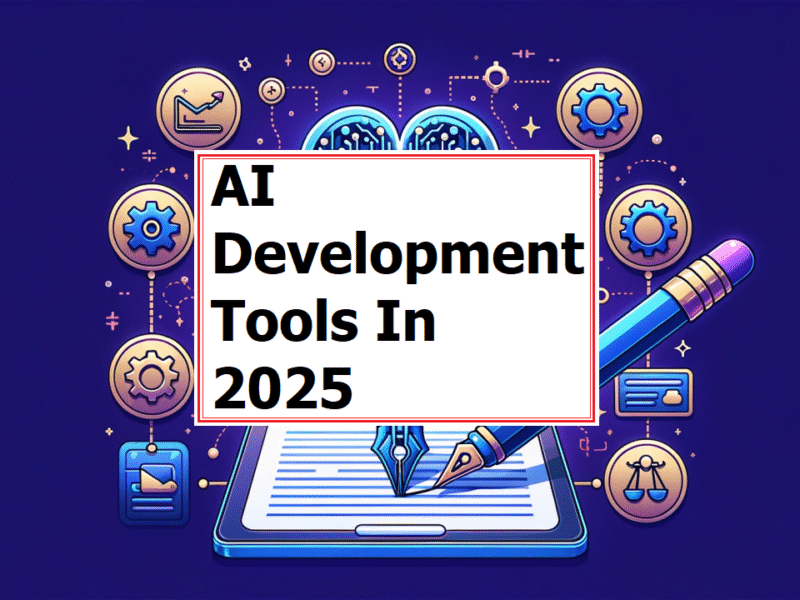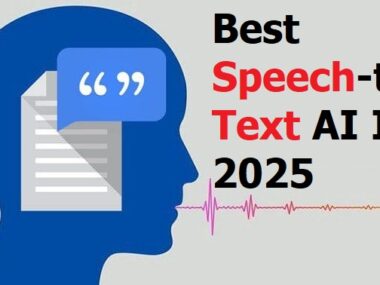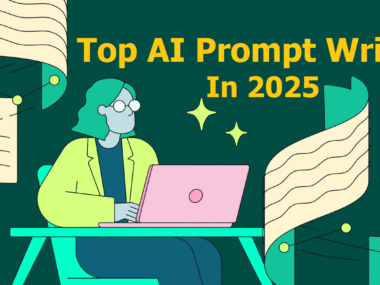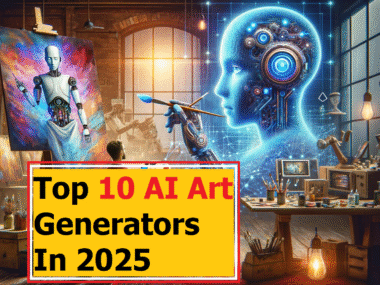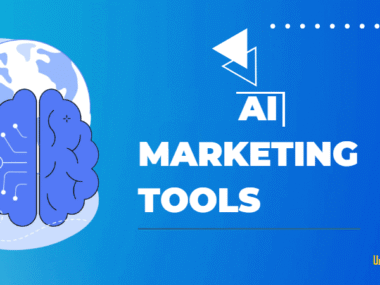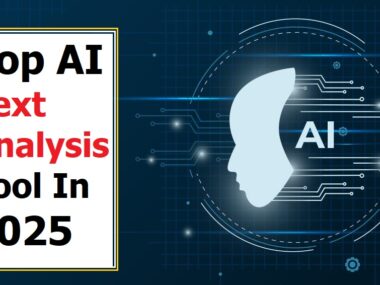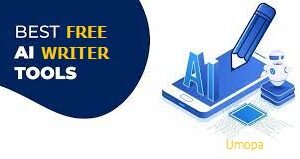Artificial Intelligence (AI) is one of the most transformative technologies in the world today. It is reshaping industries, from healthcare and finance to automotive and entertainment. Behind the scenes of every AI breakthrough are powerful AI development tools that empower engineers and data scientists to build and deploy machine learning models, natural language processing applications, and computer vision systems.
In this article, we’ll explore the top AI development tools that are essential for building AI applications. These tools encompass a range of platforms, frameworks, and libraries, each designed to simplify the AI development process.
Whether you are a beginner looking to start your AI journey or a seasoned developer seeking the best tools, this guide will help you understand the best AI development tools available today.
Table of Contents
- What are AI Development Tools?
- Why are AI Development Tools Important?
- Top AI Development Tools
- TensorFlow
- PyTorch
- Keras
- Scikit-Learn
- Apache MXNet
- Caffe
- OpenCV
- Hugging Face
- Microsoft Azure AI
- IBM Watson
- Applications of AI Development Tools
- How AI Development Tools Are Shaping the Future
- Conclusion
What are AI Development Tools?
AI development tools refer to the software platforms, frameworks, libraries, and tools that enable developers and data scientists to build, train, and deploy AI models. These tools help manage the complex tasks of data processing, model training, evaluation, and inference.
AI development tools are used across different AI subfields, including machine learning (ML), natural language processing (NLP), computer vision, and reinforcement learning. The choice of tools often depends on the project requirements, such as the complexity of the AI model, the need for scalability, and the integration of the model into production environments.
Why are AI Development Tools Important?
AI development tools are critical for several reasons:
1. Efficiency and Productivity
- AI development tools help streamline the process of building AI models by offering pre-built functions, libraries, and frameworks that automate much of the repetitive work, allowing developers to focus on more complex tasks.
2. Simplify Complex Tasks
- AI involves complex mathematical models and algorithms. Development tools make it easier for developers to work with these models by providing high-level abstractions and ready-to-use functions for data processing, feature extraction, and model evaluation.
3. Improved Performance and Scalability
- AI tools often provide optimized algorithms and hardware acceleration (e.g., GPUs) that ensure models run efficiently and scale across large datasets or distributed systems.
4. Collaboration and Integration
- Many AI tools enable collaboration between data scientists, engineers, and researchers, providing a platform for sharing models and code. Additionally, these tools offer integration with cloud services and other AI components, making them suitable for production environments.
5. Community and Support
- The best AI tools often have large and active communities. This ensures developers can find support, tutorials, and forums to troubleshoot issues and learn from others’ experiences.
Top AI Development Tools
Here are the top AI development tools used by developers and data scientists to create innovative AI solutions:
1. TensorFlow
TensorFlow is an open-source framework developed by Google for machine learning and deep learning applications. It is one of the most widely used AI development tools due to its flexibility and scalability. TensorFlow allows developers to build neural networks, train models, and deploy them on various platforms, including mobile and cloud.
Key Features:
- Open-source and highly flexible.
- Supports deep learning, machine learning, and neural networks.
- Provides pre-built models and libraries.
- Can be used for both research and production.
Why Use It:
- TensorFlow is ideal for building complex neural networks and deep learning models, especially in computer vision and NLP.
2. PyTorch
PyTorch is another open-source deep learning framework, developed by Facebook’s AI Research Lab. PyTorch is known for its simplicity and ease of use, making it popular among researchers and developers. Unlike TensorFlow, PyTorch uses dynamic computation graphs, which makes it more flexible for experimenting with new ideas.
Key Features:
- Dynamic computation graphs for greater flexibility.
- Strong support for deep learning and machine learning.
- Excellent for research and development.
- Supports GPU acceleration for faster training.
Why Use It:
- PyTorch is great for research and prototyping, as it allows for more dynamic model building and experimentation.
3. Keras
Keras is a high-level neural networks API written in Python. It runs on top of frameworks like TensorFlow and Theano, simplifying the process of building deep learning models. Keras is known for its user-friendly interface and ease of use, making it an excellent tool for beginners.
Key Features:
- High-level API for deep learning.
- Simplifies the creation and training of neural networks.
- Runs on top of TensorFlow and other frameworks.
- Suitable for rapid prototyping and experimentation.
Why Use It:
- Keras is perfect for those looking for a simple and efficient way to build deep learning models with minimal code.
4. Scikit-Learn
Scikit-learn is one of the most popular machine learning libraries for Python. It provides simple and efficient tools for data mining, data analysis, and machine learning. Scikit-learn is built on top of NumPy, SciPy, and matplotlib, and it includes tools for classification, regression, clustering, and dimensionality reduction.
Key Features:
- Simple and consistent API for machine learning tasks.
- Built-in support for classification, regression, clustering, and more.
- Extensive documentation and tutorials.
- Can be used with other Python libraries for data science.
Why Use It:
- Scikit-learn is ideal for users who want to quickly apply machine learning algorithms to their data with minimal setup and configuration.
5. Apache MXNet
Apache MXNet is a deep learning framework that supports both symbolic and imperative programming, making it a flexible option for building AI models. MXNet is widely used for natural language processing, computer vision, and reinforcement learning applications.
Key Features:
- Supports multiple languages, including Python, Scala, and Julia.
- High scalability and support for distributed training.
- Optimized for deep learning workloads.
- Strong community support from Apache and Amazon.
Why Use It:
- MXNet is ideal for large-scale AI applications, especially when working with big data and complex models.
6. Caffe
Caffe is an open-source deep learning framework primarily developed for image classification, convolutional networks, and other computer vision tasks. It is known for its speed and efficiency, making it suitable for large-scale image processing.
Key Features:
- Optimized for image classification and computer vision tasks.
- High performance and speed in training.
- Supports both CPU and GPU computation.
- Easy-to-use and modular architecture.
Why Use It:
- Caffe is great for applications that require real-time processing and high-performance deep learning models, particularly in image recognition.
7. OpenCV
OpenCV (Open Source Computer Vision Library) is a popular open-source library used for computer vision applications. It includes tools for image processing, face recognition, object detection, and more. OpenCV is widely used for real-time computer vision tasks and is compatible with many programming languages, including Python, C++, and Java.
Key Features:
- Real-time computer vision and image processing.
- Extensive library of algorithms for facial recognition, object detection, and more.
- Cross-platform support (Windows, Linux, macOS, Android).
- Free and open-source.
Why Use It:
- OpenCV is perfect for developers working on computer vision applications and real-time image processing.
8. Hugging Face
Hugging Face is a popular platform for NLP models, particularly known for its Transformers library, which simplifies the use of large-scale pre-trained models for tasks like text generation, sentiment analysis, and machine translation.
Key Features:
- Pre-trained models for NLP tasks (e.g., BERT, GPT-2).
- Simplifies the fine-tuning and deployment of NLP models.
- Huge community and resource repository.
- Supports integration with PyTorch and TensorFlow.
Why Use It:
- Hugging Face is the go-to platform for working with state-of-the-art NLP models and is widely used in both research and production environments.
9. Microsoft Azure AI
Microsoft Azure AI is a cloud-based AI service that provides a wide range of AI tools, including machine learning, cognitive services, and bot services. It offers scalable, secure AI solutions that integrate well with other Microsoft services.
Key Features:
- AI tools for machine learning, vision, language, and speech.
- Pre-built AI models for common tasks (e.g., sentiment analysis, object detection).
- Scalable and secure AI services on the cloud.
- Integration with Microsoft Power BI and other Microsoft tools.
Why Use It:
- Azure AI is ideal for businesses looking for secure, scalable AI services that integrate with their existing IT infrastructure.
10. IBM Watson
IBM Watson is a well-established AI platform that focuses on cognitive computing. It is designed to help businesses unlock insights from large datasets, build AI-driven applications, and improve decision-making processes.
Key Features:
- Natural language processing and machine learning capabilities.
- AI-powered analytics for businesses.
- Watson Assistant for building AI chatbots.
- Cognitive computing and data analysis tools.
Why Use It:
- IBM Watson is a comprehensive AI platform suitable for enterprises seeking advanced AI solutions for business intelligence, automation, and customer service.
Applications of AI Development Tools
AI development tools are used across various industries for a wide range of applications, including:
- Healthcare: AI tools are used to develop diagnostic models, predict patient outcomes, and improve drug discovery.
- Automotive: AI is at the heart of autonomous vehicle development, enabling self-driving cars to navigate and make decisions in real-time.
- Retail and E-commerce: AI is used for personalized product recommendations, inventory management, and chatbots for customer service.
- Finance: AI tools help with fraud detection, algorithmic trading, and customer support.
- Entertainment: AI is used for content recommendation systems and creating personalized user experiences.
How AI Development Tools Are Shaping the Future
AI development tools are revolutionizing how we create intelligent systems and applications. They are empowering industries to solve complex problems, automate tasks, and improve decision-making. Here’s how these tools are shaping the future:
- AI-Powered Innovation: AI development tools allow for rapid innovation, enabling companies to create new products and services that were previously unimaginable.
- Automation and Efficiency: AI tools automate tasks such as data processing, analysis, and decision-making, making businesses more efficient and cost-effective.
- Enhanced User Experiences: AI tools help companies create personalized and engaging experiences for users through intelligent recommendation systems and chatbots.
- Solving Global Challenges: AI is being used to address pressing global issues, such as climate change, healthcare, and food security, by analyzing vast amounts of data and providing insights.
Conclusion
The best AI development tools listed in this article are essential for anyone looking to develop AI solutions, from machine learning and deep learning models to computer vision and natural language processing applications.
Whether you’re a researcher, developer, or business leader, these tools provide the infrastructure needed to build powerful AI applications and shape the future of technology.
As AI continues to evolve, these tools will play an even greater role in enabling innovation across industries and solving some of the world’s most pressing challenges.
